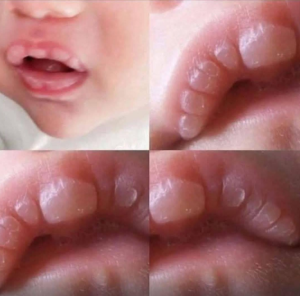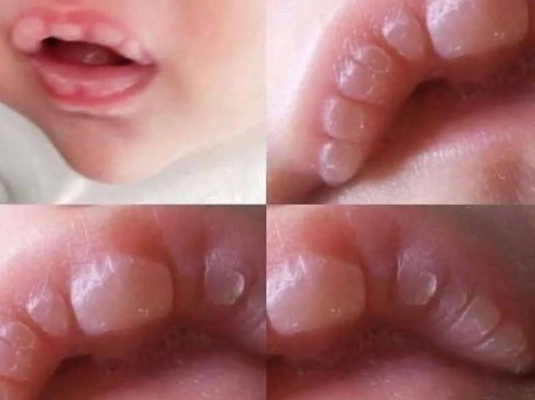⚠️ If Your Baby Has These Marks — Here’s What It Could Mean (Parents, Read Carefully!) ⚠️
Every new parent pays close attention to their baby’s skin — after all, every little spot, rash, or mark can feel like a big deal when you’re caring for a newborn. Sometimes, those small marks are completely harmless. But other times, they may carry deeper meanings — whether medical, genetic, or even cultural.
Let’s take a closer look at what different types of marks on your baby’s skin might mean, when to relax, and when to reach out to a pediatrician.
🌸 1. Birthmarks: Nature’s Signature
Many babies are born with birthmarks, and in most cases, these are totally normal and harmless. They can appear anywhere on the body — from the face to the back, legs, or even the scalp.
Here are the most common types:
-
Salmon Patches (“Stork Bites” or “Angel Kisses”)
These are light pink or red flat marks often found on a baby’s eyelids, forehead, or the back of the neck. They’re caused by tiny blood vessels close to the skin’s surface.
👉 Good news: They usually fade away within the first year or two. -
Mongolian Spots
These bluish-gray marks typically appear on the lower back or buttocks, especially in babies with darker skin tones. They might look alarming, but they’re totally benign and tend to disappear by school age. -
Café-au-Lait Spots
Light brown, flat patches that resemble coffee with milk (hence the name). Having one or two is normal — but if you notice multiple large ones, it’s worth mentioning to your pediatrician, as they can sometimes indicate a genetic condition such as neurofibromatosis. -
Strawberry Hemangiomas
Bright red, raised spots that appear weeks after birth and can grow rapidly before eventually shrinking and fading over time. Most disappear completely by age 10. -
Port-Wine Stains
These are purplish-red patches that don’t fade with time. They’re caused by dilated capillaries and sometimes linked to certain medical conditions, so it’s always best to get them checked by a doctor.
💬 2. What These Marks Can Indicate
In most cases, marks on your baby’s skin are harmless and will fade naturally. But occasionally, they can indicate something worth watching.
Here’s a quick guide:
-
Sudden Red Rash or Spots
If the marks appeared suddenly — especially with fever, fussiness, or poor feeding — it could signal an infection or allergic reaction. Always consult your pediatrician. -
Blue or Purple Marks That Don’t Fade
While Mongolian spots are normal, unexplained bruises or persistent purple patches might suggest poor circulation, bleeding disorders, or other underlying health concerns. -
Marks That Change Shape, Size, or Color
Any mark that grows rapidly, becomes raised, or changes color should be evaluated — even if it seems minor.
Remember: only a medical professional can provide an accurate diagnosis.
🌿 3. Cultural and Spiritual Interpretations
Around the world, parents have long believed that birthmarks carry special meanings — signs of luck, destiny, or past lives.
-
In some cultures, a mark on the forehead is said to represent a “kiss from an angel.”
-
In others, a Mongolian spot is viewed as a symbol of protection or a mark from ancestors.
-
Some even believe that birthmarks correspond to a lesson or event from a past life carried into the present.
While modern science explains these marks biologically, many families still find comfort or meaning in these traditional beliefs. It’s a beautiful reminder that every child is unique — body and spirit.
👶 4. When to Worry — and When Not To
Parents often panic when they notice new spots or changes on their baby’s skin. Here’s a quick checklist to help you decide what to do:
✅ Usually Normal:
-
Small, flat marks from birth
-
Faint pink or red patches
-
Blue-gray Mongolian spots
-
Isolated café-au-lait spots
⚠️ Call Your Doctor If:
-
The mark bleeds, oozes, or crusts
-
It grows rapidly or changes shape
-
You notice multiple large café-au-lait spots
-
It’s near the eye, lips, or airway (can interfere with breathing or vision)
-
Your baby shows other symptoms like fever, lethargy, or poor feeding
💗 5. How to Care for Baby’s Skin
Your baby’s skin is delicate — and so are these marks. Here’s how to protect it:
-
Use gentle, fragrance-free cleansers and moisturizers.
-
Avoid over-scrubbing or applying home remedies to fade marks.
-
Keep baby out of direct sunlight; some marks darken with exposure.
-
If prescribed, use topical treatments recommended by your pediatrician.
-
Always document changes with photos — it helps doctors track progress.
🌈 6. Emotional Side: Embracing Your Baby’s Uniqueness
Every mark tells a story. Some fade; some stay forever — but all are part of what makes your child one of a kind. Parents often worry that visible marks will affect their baby’s appearance or confidence later in life, but in truth, most fade beautifully, and those that remain can become symbols of individuality and strength.
Children grow up seeing how you see them. If you celebrate their uniqueness — every freckle, every tiny spot — they’ll learn to do the same.
🩺 7. The Doctor’s Perspective
Pediatricians emphasize one thing above all: don’t panic.
About 1 in 3 babies are born with some kind of birthmark or skin variation, and the overwhelming majority are completely harmless.
Still, it’s always wise to bring up any new or changing marks during checkups. Early evaluation ensures that if something does need attention, it’s caught quickly.
Some marks can be treated with laser therapy or medication if necessary — especially port-wine stains or large hemangiomas. Modern dermatology offers gentle, effective options that weren’t available even a decade ago.
🌟 Final Thoughts
If your baby has marks on their skin, don’t jump to fear — instead, see them as unique details of your child’s beginning. Most are harmless, many will fade, and all are reminders of how miraculous early life can be.
From a scientific point of view, these marks are simply tiny quirks of development, caused by pigment cells or blood vessels forming in specific ways before birth. From a human point of view, they’re special — the little stars that make your baby’s skin their very own constellation.
So next time you notice a mark and wonder what it means, take a deep breath. Check with your doctor, of course — but also remember: these marks often mean nothing more than your baby is healthy, unique, and beautifully theirs.


